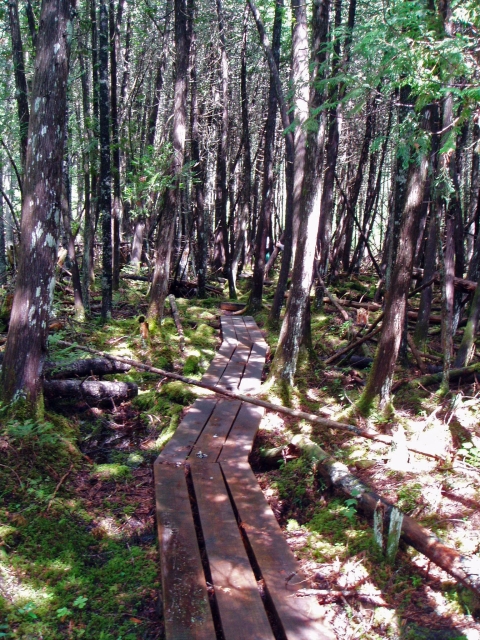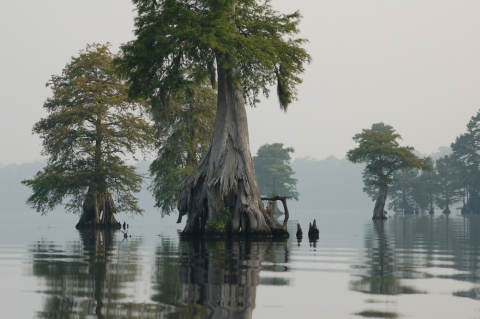Sunkhaze Meadows is the Clark Kent of refuges. Tucked in the Maine woods and accessible only by dirt road, this unassuming, little-known unit of the National Wildlife Refuge System has been quietly providing high-quality wildlife habitat and recreation while moonlighting as a climate superhero.
For the last 35 years, we've managed the peatland and surrounding forest for wildlife — like bald eagles, black terns, least bitterns, sedge wrens and yellow rails — and people, including hikers, birdwatchers, canoeists and cross-country skiers.
But for thousands of years, Sunkhaze Meadows has been forming carbon-capturing peat, an ability that has made it a superhero in the fight against climate change climate change
Climate change includes both global warming driven by human-induced emissions of greenhouse gases and the resulting large-scale shifts in weather patterns. Though there have been previous periods of climatic change, since the mid-20th century humans have had an unprecedented impact on Earth's climate system and caused change on a global scale.
Learn more about climate change .
A submerged superpower
Sitting just northeast of Bangor, Sunkhaze Meadows Refuge protects the second-largest peatland in Maine, covering more than 8,000 acres. Peatlands come in two types: bogs, which rely on rain for moisture, and fens, fed by surface and groundwater. Sunkhaze Meadows has some of each. Given the global rarity of these unique habitats — they cover just 3% of the earth’s surface — the refuge protects an ecological treasure.
Peatlands seem straight out of a Dr. Seuss book. Blanketed by sphagnum moss, which can hold 26 times its weight in water, they’re squishy underfoot, like a giant sponge, and home to the carnivorous pitcher plant, which drowns its insect prey.
When the sphagnum dies, it breaks down slowly due to lack of oxygen in the waterlogged conditions. Dead plants pile on each other, with newer layers flattening those below and forming peat that accrues at a rate of one yard every 1,000 years.
But scientists have discovered intact peatlands hold more than water; they store carbon in the dead plants that form them. This ability to act as a carbon sink is their superpower. Although they cover a small proportion of land worldwide, they hold twice as much carbon as all the world’s forests combined.
From hero to villain
Like Superman, peatlands can be, quite literally, drained of their superpower. Worse still, without water, not only do they lose their carbon-storing ability, they contribute to climate change. Air is their Kryptonite.
When once-submerged plant matter is exposed to air, decomposition ramps up, releasing stored carbon as carbon dioxide and warming the planet. The warmer the climate gets, the faster drained peatlands will dry out, creating a dangerous feedback loop.
People have drained peatlands for centuries to harvest moss and peat for fuel, gardening and agriculture. Roughly 15% of the world’s peatlands have been drained, and another 5-10% are degraded. Each year, peatland destruction sends nearly two billion tons of carbon dioxide into the air, the same amount produced by 535 coal-fired power plants annually.
Close call
In countries like Ireland and Finland, people burn peat for heat and power. Following the energy crises of the 1970s, some Mainers looked to peat as a homegrown, less-expensive alternative to coal and fuel oil. Not only was it available locally, cutting transportation costs, it was right on the earth’s surface … no costly, dangerous mining necessary.
In 1983, the Maine Geological Survey assessed the state’s peatlands for energy and agricultural potential. With more than 3,300 acres of harvestable peat, 15 feet deep in some places, Sunkhaze Meadows drew the attention of a peat-mining company.
Fortunately, interest in peat as an energy source waned before the company could act. Community members recognized the value of the site in its natural state and organized to save it from development. The Nature Conservancy purchased the site in April 1988. Later that year, we used money from the Land and Water Conservation Fund to acquire the parcel, forever protecting it for wildlife and recreation.
No cape required
From the start, we’ve cared for Sunkhaze Meadows with a light touch, focusing on protecting the peatland and its surroundings while welcoming the public.
"Although the refuge's value to wildlife doesn't depend on active habitat management, we carefully monitor plant and animal populations, groundwater levels and quality, and any potential effects on the habitat by users or activities adjacent to the refuge," said Refuge Manager John Magera. "Some restoration has taken place since the refuge was established, such as removal of trash dumps, old cabins and roads, but fortunately most of the area continues to provide quality wildlife habitat without the need for improvement."
And what of its value to the planet? Protecting the refuge’s 3,300 acres of commercial-quality peat — less than half its total peatland — provides about the same climate benefit as ongoing carbon sequestration in 25,000 acres of forest. It would be hard to improve on that.
Power lost, power restored
The Great Dismal Swamp in Virginia and North Carolina was not as lucky as Sunkhaze Meadows. People worked for centuries to drain the million-acre peatland for timber harvest.
The swamp’s remaining 113,000 acres became a national wildlife refuge national wildlife refuge
A national wildlife refuge is typically a contiguous area of land and water managed by the U.S. Fish and Wildlife Service for the conservation and, where appropriate, restoration of fish, wildlife and plant resources and their habitats for the benefit of present and future generations of Americans.
Learn more about national wildlife refuge in 1974. We’re restoring its natural function by bringing back water, allowing it to hold enough carbon to offset the annual emissions of 42,000 vehicles.
“When you affect the hydrology of wetlands,” said Scott Covington, senior ecologist for the refuge system, “you convert them from carbon sinks to carbon sources. Restoration can put them back on the right side of climate change.”
A wet Great Dismal Swamp is also less likely to burn, as it did twice earlier this century — releasing six million tons of carbon into the atmosphere.
A system of carbon sinks
Sunkhaze Meadows’ story isn’t unique in the refuge system. Set aside to conserve wildlife habitat, many refuges are also carbon repositories, as critical to slowing climate change as they are to sustaining wildlife.
Many national wildlife refuges protect coastal wetlands, including salt marshes and mangrove swamps, which are also carbon-storage superheroes. Much like peatlands, plant material in these saturated, “blue carbon” areas is slow to break down, locking away climate pollutants.
We’re working with the U.S. Geological Survey to assess the carbon storage capacity of various refuge habitats. Ideally, we’ll learn where we can get the “biggest bang for the buck” by restoring degraded landscapes for both wildlife habitat and carbon storage.
“We want to know what our carbon footprint looks like,” said Covington. “Are we seeing some of our carbon sinks turn into sources, and what can we do about that?”
As Sunkhaze Meadows shows, the ideal is to maintain healthy, intact habitat from the start. But if that opportunity is missed, all is not lost. Just like Superman, peatlands and other habitats can regain their superpower, helping save the world.







